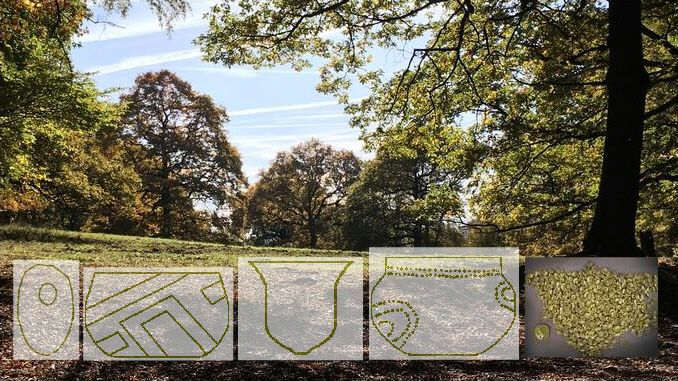
Very early on, in the Upper Paleolithic, there were human beings in our region. The first finds date back to the early history of the Siebengebirge. In Oberkassel, the bones of a man, a woman, and a dog were found who must have lived around 13,000 BC. You can see them in the museum Rheinisches Landesmuseum in Bonn.
Early history and ancient civilizations
After the Ice Age, in the Mesolithic, a more favorable climate brought better living conditions. In the “Fertile Crescent” of the Near East, there were early settlements, and people settled mainly on the coasts and banks of rivers and lakes.
In the Neolithic (5,500-2,200 BC), different people migrated through Europe, met and gradually settled down. There was a transition from hunter-gatherers to farmers who tilled their fields, raised livestock, and produced provisions. Yet, unlike the well documented Oriental advanced civilizations, they remain anonymous “people” to us. We describe them by the jewelry, utensils, and weapons made by them, or by the way they buried their dead.
Stone Age
At the beginning, there was the Linear Pottery Culture that had probably come from the Near East. Back then, people were looking for fertile loess soils, and they found them on the left side of the Rhine. We know about a Linear Pottery settlement near Cologne.
The Rössen culture probably developed from the Linear Pottery around 4,500 BC. Characteristic tools are wedges and axes with holes. Such tools have been found in the Siebengebirge area, ear the Kuckstein and in Thomasberg.
As the next cultural stage, the Michelsberg Culture appeared in the Late Neolithic on both sides of the Rhine. Characteristic are tulip beakers. There are finds from the Michelsberg Culture In the Siebengebirge. The Petersberg and its surroundings were inhabited around 3500 BC, and perhaps there was a prehistoric settlement on the “Mondscheinwiese” between Petersberg and Nonnenstromberg. However, as mentioned above, we know very little about the early history of the Siebengebirge, so we often have to say “perhaps”.
At the end of the Stone Age, there were two cultures that knew metal: the Corded Ware Culture and the Beaker Culture, Both met at the Rhine. Copper emerged as a new material, and the Beaker Culture is considered the first metalworking culture in the Rhineland.
Bronze Age
We think of Homer’s heroes, the gold hats, the Trundholm sun chariot and the Nebra sky disk. In the Orient and in Central Europe, people observed the sky. The Nebra sky disc is 3,600 years old; you can see the moon, the sun, and stars, probably the Pleiades. We still know little about the Bronze Age. This is especially true for Central Europe because the people in our region did not yet know any writing and have not handed down anything. So, we still talk about anonymous people, which we distinguish according to the way they buried their dead.
Iron Age
In the historiography about the rise of Rome (from the 5th century onwards) we do not meet anonymous “people” anymore. Roman and Greek historians have recorded all that for us. Now we read about tribes and civilizations to which we can assign specific cultures, for example the Iron Age cultures of Hallstatt (as of 800 BC) and La Tène (as of 450 BC). After the Punic Wars, Rome was the antique world power. All the countries around the Mediterranean Sea and large parts of Western Europe were in Roman possession.
Siebengebirge: a settlement on Mount Petersberg
In contrast, we know little about the early history of the Siebengebirge, and what we know comes from Roman sources. The early Germanics and Celts in our region were illiterates. Moreover, there are only little archaeological finds from the Roman era here on the right bank of the Rhine. Back then, the Siebengebirge was in the border zone between the Teutonic civilization in the north and the Celtic civilization in the south. More and more Germanics left their homelands in the north and northeast that were often devastated by floods, and broke into Celtic settlement areas at the rivers Rhine and Moselle. There were settlements on the Petersberg and between the mountains Petersberg and Nonnenstromberg. Part of the circular settlement wall around the Petersberg plateau (around 100 BC) has remained.
The Gallic War
Caesar’s Gallic War (58-51 BC) brought Roman soldiers to the Rhine. In seven years of campaigning, he defeated the Celtic tribes in Gaul. He also fought the Germanic tribes who crossed the Rhine: the Sugambri, the Usipetes and the Tencteri. Twice Caesar had bridges built and crossed the Rhine for punitive raids. In 52 BC, he controlled Gaul.
The Rhine became the border between the recently conquered areas Germania Inferior and Germania Superior and the free Germania Magna.

Be the first to comment